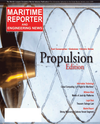
Page 39: of Maritime Reporter Magazine (September 2011)
Marine Propulsion Annual
Read this page in Pdf, Flash or Html5 edition of September 2011 Maritime Reporter Magazine
September 2011www.marinelink.com 39engine, efforts were made to find suitable alternative combustion processes over a period of more than two decades. Besides the hot bulb engine, a type developed by Jan Brons of the Netherlands may be re-garded as the precursor of the antecham-ber engine. Using more advanced designs, the firm asmotorenFabrik Deut equipped many fishing vessels and other small ships for several decades. Other methods were tried but did not lead to sustained success. Produced from 189to 189 at Maschinenfabrik Augsburg (which later became MAN) with consid-erable support from einrich von Bu and Friedrich Krupp in Essen, the dieselengine was first used for ship propulsion in 190. Up to the Selandia in 1912, which is regarded as the first seagoing motor vessel, other manufacturers pro- duced various marine diesel engines, pri- marily for inland waterway vessels, some also without a reversing facility. This led to the first dieselelectric transmission in 190 with Vandal, a ussian river tanker of 50 tonnes. With his rational heat engine of 189, udolf Diesel pur- sued the aim of developing a power plant to supersede the steam engines and all known combustion engines. owever, more than 60 years were to elapse fromthe birth of this grand idea up to full re-placement of the steam engine in ship-ping.The first main prerequisite for ship op- eration at large output levels was the abil- ity to reverse the running direction of the engines, which was achieved in 1910. At the time, the propulsion plants employ- ing diesel engines were still quite large and very heavy. Compressed air was used to blow the fuel into the combustion chamber. ere an air compressor was needed to achieve a much higher pressure for the air than was possible by the com- pression of the engines.BEAU F E DESE ENNE It was only the hydraulic injection of fuel developed by Motorenfabrik Deut in 1921 for large engines that brought about decisive change. Marine diesel en- gines became lighter, smaller and could be operated at higher speeds. This leap in innovation also allowed the construction of much more powerful units. Another factor was that the structure of the marine diesel engine had, until then, primarilyfollowed the steam engine. The engines produced by Burmeister Wain in Copenhagen were exceptions to this rule. The application of the BW design prin- ciples and hydraulic fuel injection gave the diesel engine its br eakthrough as amarine drive. The final step towards at- taining diesel engines of high power, as used today, was taken by Alfred Bchi of Switerland with the exhaustdriven tur- bocharger developed in 1905. When it then also became possible to producepowerful turbochargers, which were needed for operation with twostroke diesel engines, the ambitious goal ofudolf Diesel was ultimately achieved in the mid1950s and, even then, the de- velopment of the marine diesel engine still did not end there. his article is reprinted with permis sion from ermanischer lod. It or giainall published in s inhouse publication, ontop, issue , , pages

 38
38

 40
40
